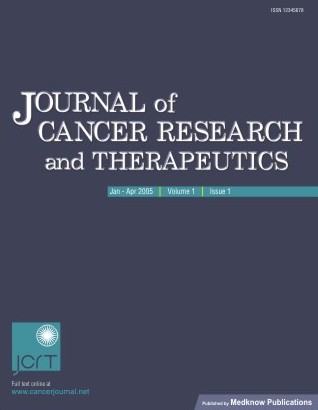
|
Journal of Cancer Research and Therapeutics
Medknow Publications on behalf of the Association of Radiation Oncologists of India (AROI)
ISSN: 0973-1482 EISSN: 1998-4138
Vol. 2, Num. 4, 2006, pp. 159-160
|
Journal of Cancer Research and Therapeutics, Vol. 2, No. 4, October-December, 2006, pp. 159-160
Invited Editorial
Advances in radiation oncology: Time to move ahead
Rath GK, Sharma DN, Bahl Amit
Department of Radiation Oncology, Institute Rotary Cancer Hospital, All India Institute of Medical Sciences, New Delhi - 110029
Correspondence Address:Department of Radiation Oncology, Institute Rotary Cancer Hospital, All India Institute of Medical Sciences New Delhi - 110029,gkrath@rediffmail.com
Code Number: cr06040
The nineties have seen a paradigm shift in the practice of radiation oncology in our country. The tremendous technological advancement witnessed during this period coupled with an ever-increasing incidence of various malignancies and their early detection has placed the discipline of radiation oncology in an envious position. With it comes the responsibility to effectively capitalize on this opportunity and to have in place long term strategies which not only ensure best patient care but also helps our specialty to keep pace with international developments. As our country slowly moves out of the era of cobalt-based conventional treatment to linac-based conformal and image guided therapy, this transition though relentless has to be judicious and moderated. Our country with its 0.8 million annual new cancer cases has a huge burden of patients needing highly specialized radiation oncology treatment. About 70-80% of these patients will need radiation treatment at some point of their treatment.
Intensity modulated radiotherapy (IMRT) which can precisely conform high doses to tumor area while protecting organs at risk can be an effective tool for reducing radiation treatment morbidity and has promising potential as a dose escalation tool. However concerns remain about increased total body doses in such treatments and their long term implications. Another area of concern is organ motion during treatment. Image guided radiotherapy (IGRT) involving state of art, tumor tracking systems, takes care of organ motion and can deliver highly accurate treatment. Cyberknife is the most recent advancement which is being tried in moving lesions in the lung and prostate. The combination of the above modalities appears to be an optimum patient care system. Proton therapy due to its unique energy deposition characteristic is proving to be a useful tool in management of certain malignancies involving skull base and others like uveal melanomas. High dose rate brachytherapy has already established itself as an effective tool and has changed the way we practice brachytherapy. The shorter treatment times coupled with computer assisted treatment planning is expanding the horizons of brachytherapy applications in various clinical situations. With the help of mammosite, a new concept in the form of accelerated partial breast irradiation (APBI) is becoming very popular for treatment of early breast cancer. Similarly gliasite is also being tried for the brachytherapy of brain tumors. Intraoperative radiotherapy (IORT) involves delivery of radiotherapy at the time of surgery and it has the advantage of accurate tumor bed visualization while ensuring proper shielding for surrounding normal structures. However its practice has still to pick up in our country and it needs a combined team effort of radiation and surgical oncologist.
Combination of radiofrequency ablation with brachytherapy is another form of conformal treatment also being explored to take care of residual diseases after conventional treatment. Radiofrequency ablation has shown good results particularly in management of hepatic metastasis. The advent of newer metabolic imaging devices like PET scan promises to open up newer possibilities in tumor contouring and may redefine the concept of GTV, CTV as practiced today. Studies using extracranial stereotactic radiotherapy have already used large single fraction treatments and advent of these newer technologies may lead to a fresh look at altered fractionation schedules.
Though these newer modalities continue to be monitored critically, the emerging long term results and follow-up appear to be promising. These modalities with time may undergo refinements and modifications but they are here to stay. Though the cost benefit issue may take a longer time to be answered the treatment scenario envisaged appears scientifically sound.
These developments also mandate a fresh look at our physician training programs. Appropriate training in image acquisition and interpretation would be highly useful in this scenario to prevent systematic errors in treatment planning. Incorporation of a good quality assurance programme to monitor treatment delivery and execution is another challenge to be met head on.
The need of the hour in our country is to encourage the setting-up of newer modern facilities and upgrading the existing ones in the larger interest of patient care and also for physician training. However prudent clinical judgment must be used in applying these new tools as indiscriminate and over enthusiastic usage may not auger too well in this era of evidence-based medicine.
Copyright 2006 - Journal of Cancer Research and Therapeutics
| 